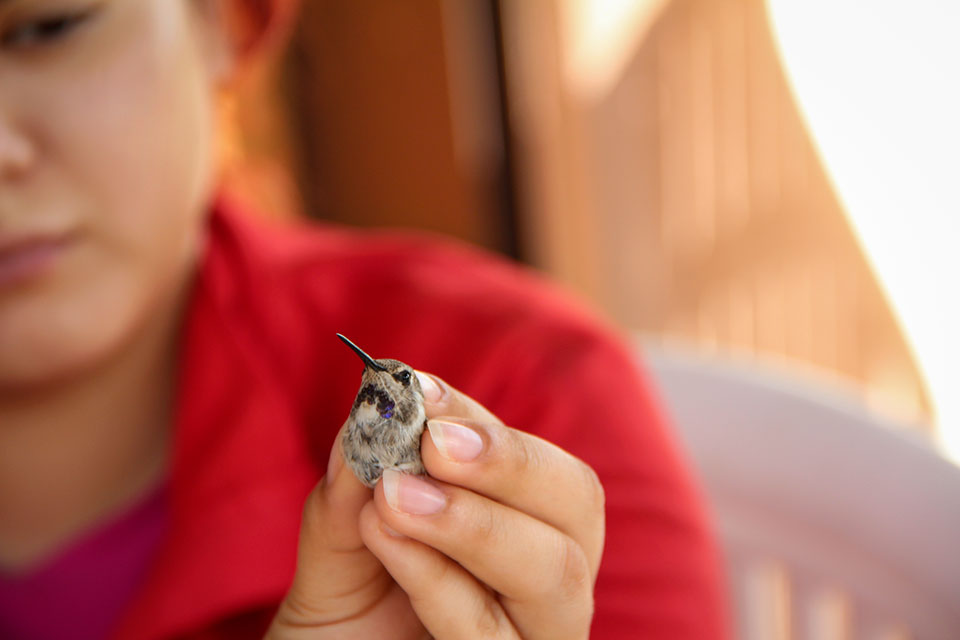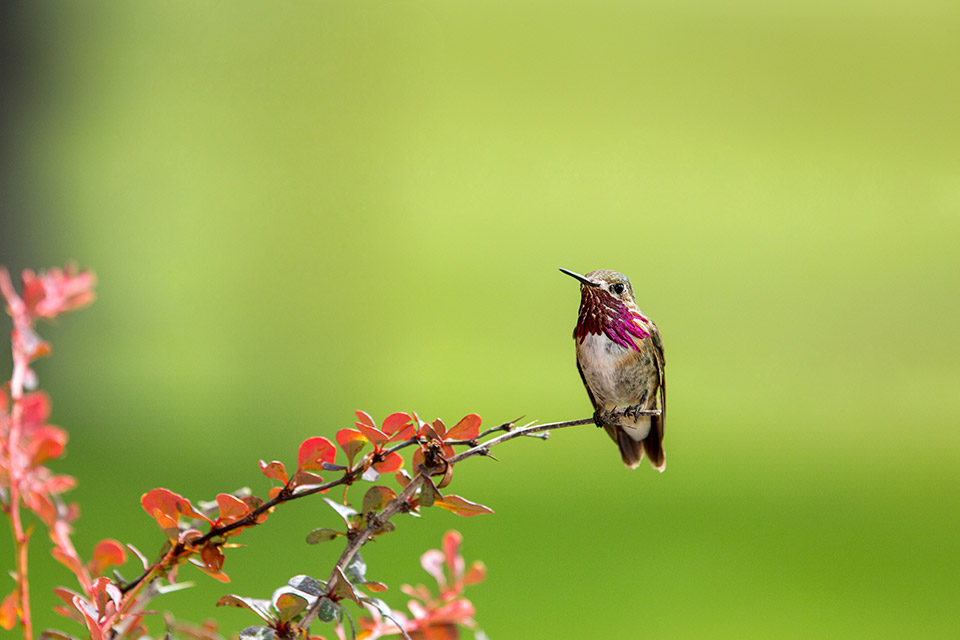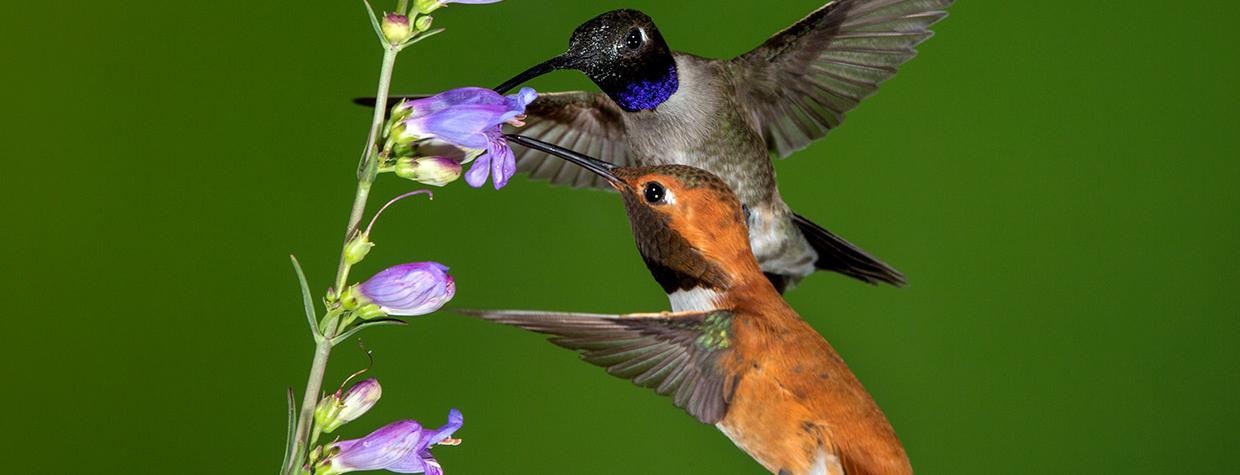This story ran in Arizona Highways' January 2015 issue.
Editor’s Note: If you’re a longtime reader of Arizona Highways, you’re familiar with Charles Bowden. For decades, his beautiful words have been appearing on the pages of our magazine. Sadly, Mr. Bowden died unexpectedly on August 30, 2014. Like so many others, we were devastated by the news. As a writer, teacher and friend, he leaves a void that cannot be filled.
Toward evening during the hot breath of summer, the desert air matches the body temperature and the line dissolves between your body and the world around you. As a boy, I’d walk the dog under a tree in the corner of the park at twilight and hummingbirds would hover just over my head. I knew nothing of their customs or various nations then. But my boy’s eyes glimpsed an open door as the night came down and the promise of what I could be and learn if I left the everyday world and spun up into the sky.
For a long time I seemed to lose that feeling, but now I want to find that open door again. A rufous comes to the feeder, a blaze of rust and gold to my eye. A year ago, one was banded a few miles from where I sit, and 18 days later it was netted again 1,300 miles north in British Columbia. The bird is tiny, and within its flash of color and that huge distance is the magic I glimpsed as a boy and now want back.
Susan Wethington sits at the table on Harshaw Creek close by the Mexican border. She is a founder of the Hummingbird Monitoring Network (HMN). Arizona hosts 14 or 15 species of hummingbirds, and increasingly a raft of guides and bed-and-breakfast spots cater to those drawn to the birds. And yet not much is known about them. The network (10 to 13 sites in Canada, the U.S. and Mexico, plus 300 to 400 volunteers) sets out to find out what they are up to. Her husband, Lee, is busy trapping, and Susan and an assistant examine and band them.
Susan was a computer-development engineer for IBM, then fell in love with hummingbirds, went back to school for a doctorate in ecology and evolutionary biology, and is the center of the Hummingbird Monitoring Network. She can’t quite say what drove her to this decision. She is a person who has always taken life one step at a time and then one day, she says, “I knew I had to take a different step.” Maybe what moved her from IBM to this small watershed is captured in the motto of HMN: “Protect the Joy.”

As I watch her I can feel the wonder of those moments under that tree in the park. The crack in the sky once again opens up for me.
It’s a little before 6 a.m. at the tail end of July, and she cradles a broad-billed male.
As hummingbirds go, the broad-billed is small — 3 to 4 grams, less than an ounce. It’s a border bird, poking up from its wintering ground in Mexico to breed into Arizona, New Mexico and the Big Bend area of Texas. We don’t know much about it — there is not much research on its sounds, social moves, courtship flights or what any of this means. This is pretty much our current knowledge of hummingbirds. They hover right in front of our face, but we hardly know their worlds.
Susan holds the bird in her right hand, checks its weight and general condition — Does it have fat? Is it molting? — and slips on a band. The bird is green with a splash of blue at the throat, an orange bill with a dark tip, everything we find beautiful. In front of Susan are 10 different band sizes on spikes in a rack made by Lee. There is a separate rack of tiny pliers he’s also made. Lee’s another retired IBM engineer. He’s fashioned the net traps he springs to catch hummingbirds. And off to the side of their house is a bread oven he fashioned because Susan loves to bake — “She still owes me some cookies.” But everything here comes in second to hummingbirds.
The broad-billed birds earn a kind of affection from her because after all the weighing and measuring and banding, they remain very calm and will sit on an open palm sometimes for minutes before they fly away in a flash. The observations go into a computer database, and inside all these captures — here and at the other sites — there is the promise of finally learning a little of what that broad-billed knows. And what the other hummingbirds know.
This morning the traffic is mainly broad-billed, rufous, violet-crowned, Costa’s, black-chinned. When they set up the banding operation about 10 miles east on the grasslands around Sonoita, the traffic was almost totally male black-chinneds. There are highways out there known to hummingbirds that are just coming to our attention, just as there are traffic customs — separate migrations of males, females, juveniles — that we are only beginning to brush against. We know male broad-billeds seem to have favorite singing perches, but we are ignorant of the purpose of their dawn and evening songs.
Hummingbirds hail from back of the beyond, possibly
20 or 30 million years ago, but the growth of the species came in South America 12 to
13 million years ago when the Andes rose up. Their past is hard to track — the tiny bones do not lend themselves to fossil preservation. The oldest fragment was found in Germany. Today, they exist solely in the Western Hemisphere and were a surprise to Europeans when they stumbled onto this New World. But hardly to the natives. Almost any culture that knew hummingbirds took note of them. The Aztec emperor wore a robe of hummingbird skins. Huitzilopochtli, the sun and war god, was portrayed as a hummingbird. It was thought that dead warriors became hummingbirds.
Americans began to really look at hummingbirds about 70 years ago. The first successful field guide did not come until the 1930s, and hummingbird feeders only hit the market around 1950. We’re still almost on our first date.
They live faster than we can imagine. The wingbeats can go up to 200 beats per second, but most species range from around 10 to 80. They are a blur to our eyes. We have some numbers — they can fly from around 17 miles an hour on the level to power dives of 45. But in the hummingbird world, scientists lean toward a different measurement — how many body lengths they can move in a second. One study found 385 body lengths per second. To put this in some kind of human perspective, the space shuttle hit 207 body lengths per second and the peregrine falcon, generally seen as the avian rocket, maxes out at 200 body lengths per second. During their courtship dives to dazzle females, a male hits a G-force of nine times gravity, something in the range experienced by a jet fighter.
They have such high energy needs that they go into a kind of torpor at night, the heartbeat falling from 1,200 a minute to 200 lest they starve to death before dawn. And yet, somehow, one of the smaller hummingbirds, the rufous, migrates from Southern Mexico up to Alaska, 2,700 miles each way. In their journey, people with feeders always know when they are moving through because even in the busy world of hummingbirds their boisterous ways stand out and suddenly a backyard feels as if an outlaw motorcycle gang has descended.
All this is part of what took Susan from the computer industry to a table and banding station on Harshaw Creek. But beneath all the claims of science a kind of magic lurks, and within the magic is simply the hunger to know what hummingbirds are about. They are creatures of habit. In the spring, 60 to 70 percent of the birds captured on the creek have already been banded — this drops to about 30 percent in the late summer as the newly hatched birds show up at the feeders. She is working on a young black-chinned now, delicately placing a band, and it keeps chirping — “They tend to talk” — and Susan stares through her four-power visor and says things like “Cool.” She looks up and sees Lee has a rare failure at trapping a hummer, and she says, “Bummer.”
The individual birds are hanging in sacks from a carousel Lee has created and wait their turn. When Susan has finished, she hands them off to Denise Sandoval Quintana, a student from Ciudad Obregon, to weigh. Denise is part of the outreach of the network, and at the moment other students from Bolivia, Ecuador and Peru are also working the creek, a defile lined with cottonwoods and sycamores and stretches of water from the summer monsoon. Sometimes the birds are a little flustered from being kidnapped in the name of science, and Denise will hold one in her hand, swoop down as if to a flower, and insert its bill in a feeder on the table.
“And then they calm right down,” Susan notes.

The work goes on amid sounds — the call of a yellow-billed cuckoo, the chirp of a hooded oriole in the mesquite, the whirring of hummingbirds that continue to feed on flowers around the lab table, the light clatter of little tools as Susan moves from one task to another, and the soft sound of Susan blowing through a straw to lift up the chest feathers and check the birds for the fat they will need for the looming migration. This is science with a hummingbird face.
One summer they caught two hummingbirds that were always together — they could tell this from the record of the bands. Hummingbirds are seen as antisocial, but still these two seem to live as a team. And some of the visitors here keep coming back for more. One broad-billed has been captured for eight years. Hummingbirds were once thought to live fast, short lives. But banding has found one bird that was 11.
Eleven species have been captured and banded on Harshaw Creek, but there is no telling what is in store in the future. On the one hand, the creek is drying out — the students from South America are part of a restoration project among other things — and the temperatures are rising. For a bird with high energy needs — much like modern America — such changes can be wrenching. On the other hand, science has tried to look at hummingbirds from the beginning to now and finds more than 300 species, and if this growth is pushed ahead millions of years there could be 700 types of hummingbirds eventually, a possibility that tantalizes Susan.
At the table on this summer morning on Harshaw Creek down near that Mexican border, Susan becomes the confluence between the rigor of science and the drive of her passion. She is all numbers as she fills in the form on her clipboard with data on each bird. She teaches classes on banding and finds that not everyone can do it, that dealing with something as small, fragile and lively as a hummingbird requires a certain touch. She rolls a bird over, blows through her straw and there suddenly is the puncture wound left when another hummingbird stabbed it with its beak.
Hummingbird aggression is an open question. There is no doubt they fight for food and territory, but Susan wonders if human observers mistake some of the moves for aggression when it is simply the darting about of a fellow creature that seems to roar through life. We are stunned by their energy. After reveille, a hummingbird feeds and then wanders 5 to
8 kilometers in the morning checking out various flowers. Their migrations are so vast that humans persist in thinking they hitch rides on the backs of geese — and no, they do not.
We are all seduced by hummingbirds, by the flash of color, the sudden iridescence, the rapid movement, the hovering, and the fact that something so small will fly right up to our face. In a world where so much of the wild flees at our approach, hummingbirds seem to promise redemption, whatever the real reason for their behavior.
Which is part of Susan’s hope and possibly her own experience.
“Hummingbirds,” she argues, “are one of the few animals people connect with immediately, and every culture with hummingbirds has a positive connection. I think hummingbirds provide an opportunity to engage people in nature and open eyes to the natural world. And quite frankly, if we can’t save hummingbirds, what group of animals can we save?”
By 10:45, 60 birds have been tagged and processed.
If you want to see the widest array of hummingbirds in the U.S., you come to Southern Arizona. And if you want to see the only future worth being part of, you join the world of hummingbirds. They are flashy and quick and on the move. Given their high food needs, the future could be threatening to them. Given their millions of years of riding out the storms of life, their track record puts our own in the shade.
There is always a temptation to say too much about hummingbirds because they hover within our reach and meet our gaze.
They’ve weathered tens of millions of years and they are still in our face.
I don’t think we know what is going on in their minds or their worlds.
Here on Harshaw Creek and other similar spots, we just might begin to learn.
Protect the joy.

